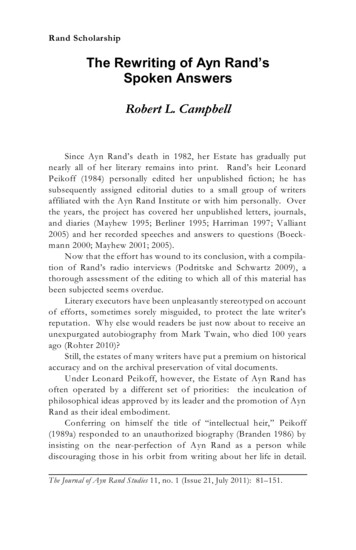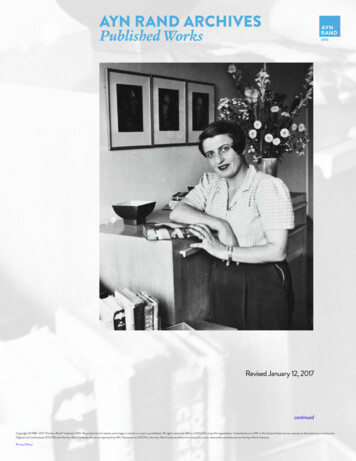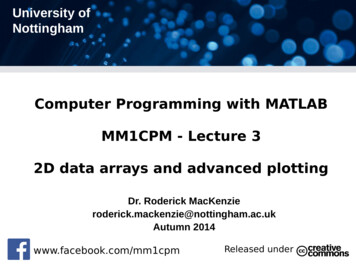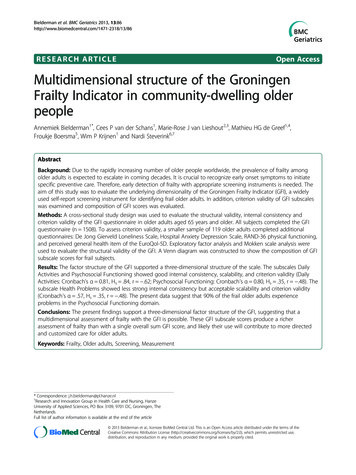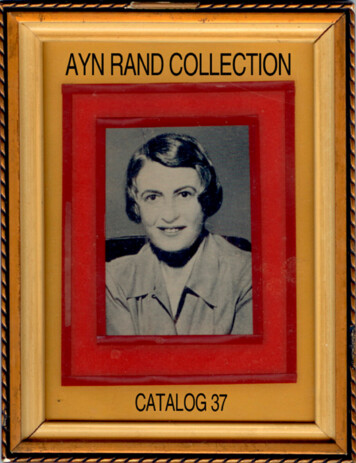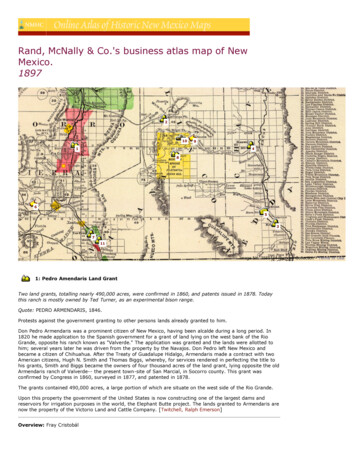
Transcription
Rand, McNally & Co.'s business atlas map of NewMexico.18972109148653711Image No: 3565144 Rumsey Collection - Terms of Use1: Pedro Amendaris Land GrantTwo land grants, totalling nearly 490,000 acres, were confirmed in 1860, and patents issued in 1878. Todaythis ranch is mostly owned by Ted Turner, as an experimental bison range.Quote: PEDRO ARMENDARIS, 1846.Protests against the government granting to other persons lands already granted to him.Don Pedro Armendaris was a prominent citizen of New Mexico, having been alcalde during a long period. In1820 he made application to the Spanish government for a grant of land lying on the west bank of the RioGrande, opposite his ranch known as "Valverde." The application was granted and the lands were allotted tohim; several years later he was driven from the property by the Navajos. Don Pedro left New Mexico andbecame a citizen of Chihuahua. After the Treaty of Guadalupe Hidalgo, Armendaris made a contract with twoAmerican citizens, Hugh N. Smith and Thomas Biggs, whereby, for services rendered in perfecting the title tohis grants, Smith and Biggs became the owners of four thousand acres of the land grant, lying opposite the oldArmendaris ranch of Valverde-- the present town-site of San Marcial, in Socorro county. This grant wasconfirmed by Congress in 1860, surveyed in 1877, and patented in 1878.The grants contained 490,000 acres, a large portion of which are situate on the west side of the Rio Grande.Upon this property the government of the United States is now constructing one of the largest dams andreservoirs for irrigation purposes in the world, the Elephant Butte project. The lands granted to Armendaris arenow the property of the Victorio Land and Cattle Company. [Twitchell, Ralph Emerson]Overview: Fray Cristobál
Named for a member of the Oñate entrada, the Paraje de Fray Cristóbal remained important throughout theperiod in which the Camino Real was in use. Oñate's men facetiously remarked that the outline of the ridge ofthe mountain near present Elephant Butte Reservoir looked like the profile of Fray Cristóbal, saying he was"feisimo" (politely, not very good looking). It was described as a general area rather than a particular point butcan be defined by its proximity to both the Río Grande and the Jornada del Muerto. In the nineteenth century,Fray Cristóbal became Fra Cristobal, as a modern local spelling and pronunciation without a y in Fray andwithout an accent in Cristóbal. [Long Distance Trails Group--Santa Fe, National Park Service, New MexicoState Office, Bureau of Land Management]Links:El Camino Real International Heritage Center: Jornada del Muerto .htm2: White Oaks District1897Quote: By 1885 White Oaks had assumed the semblance of a a real town. Streets and cross streets had beensurveyed and laid out. Store buildings and dwellings were all in line. The early-day boom-town atmosphere,featuring saloons, wide-open gambling, and guns and Bowie knives dangling from belts, had practicallydisappeared. The majority of the citizens were law-abiding, progressive people, unafraid and confident of thefuture.For those who drank water [as opposed to whiskey], there were wells. A few residents had their own, dugdown to water level at thirty-five to forty feet below the surface. The water was "hard," impregnated withalkaline salts. The public was dependent for its drinking water on a water wagon, a cylindrical wooden tankhauled by a span of horses. Delivery was made to a barrle standing in the yard of each dwelling. The pricewas fifty cents, later reduced to twenty-five cents, a barrel, forty gallons.In later years a number of the better houses, those with pitched roofs of sheet iron or shingles, had cisternsfor catching rain water, soft water used only for drinking and bathing. To soften the well water, we used theroot and core of the amole cactus [agave parryi], abundant in the vicinity. We shredded it, pounded it, andstirred it into the water. This native Mexican stunt later became the basis which produced Amole soap.We certainly did not live a life of luxury, but we ate surprisingly well. In addition to the bread from ourweekly baking we used a great deal of cornbread, cornmeal mush, and oatmeal, along with hot cakes drenchedin molasses or syrup. Our coffee was the well-known Arbuckle's roasted, purchased in one-pound packages atthree for a dollar. We ground it at home in a grinder fastened to the kitchen wall.Fresh vegetables, in season, came from one local farmer, a Frenchman of peculiar character. He spoke butlittle English and his prices were sometimes confusing: One bunch of onions, ten cents, two for a quarter.Tom Osborn, a long-range cross-country peddler, provided our main supply of oranges, apples, watermelons,and so forth, and our potatoes, onions, and turnips on occasion. Back and forth he traveled with his team andcovered wagon-- from Las Vegas 175 miles north; from Tularosa 45 miles south; from Hondo and Ruidoso 60miles east. He was one of the most popular and welcome tradesmen in our midst. Two, three, or more timeseach year, he came in loaded and went out empty with his profits, leaving us happy with the muchappreciated luxuries he had provided.Sugar came in hundred-pound sacks, flour and beans in fifty-pound sacks, rice, salt, and other commodities insmaller sacks. We got our salted mackerel in wooden tubs. Codfish came in slabs, bacon in sides ham andshoulders as the Lord made them. Canned goods-- corn, tomatoes, peas, condensed milk when it becameavailable-- were often purchased in case lots and shipped in with other freight. [Parker, Morris B.]Overview: White OaksThe discovery of a rich vein of gold in 1879 drew prospectors, speculators, miners, and settlers to this remotearea by the hundreds. Within three years, the dusty streets had been planted with trees, Starr's Opera Housewas open for business, as well as a school, a town hall, a newspaper office, and the ubiquitous saloons.Billy the Kid menaced the prosperous merchants and ranchers of White Oaks, and while the town's possefailed to track him down, outrage over his destructive and murderous activities led to Governor Wallace issuinga reward for bringing the Kid to justice.Several major discoveries did not keep the mines from running out within thirty years, and although theresidents of White Oaks lobbied hard for a railroad, Charles Eddy decided instead to route his line throughCarrizozo. Before long, White Oaks began to decline, and today only about a dozen residents remain.Today's visitors can explore the past at the Cedarvale Cemetary, the White Oaks Schoolhouse Museum, theMiner's Home Museum, and the No Scum Allowed Saloon. [Western History/Genealogy Department, DenverPublic Library]
Links:White Oaks New Mexico -- http://whiteoaksnewmexico.com3: Eddy1889Quote: Eddy County was organized in 1889, the year before I moved there. Charles B. Eddy was the managerand part owner of the Eddy-Bissel Live Stock Company. He took the initiative in the organization of the countyand in selecting the county seat, and in its developments. He also took th einitiative in building the railroad,and the canal, dams, and reservoirs for irrigation from the Pecos River. He lived in a little rock house acrossthe river in what is known as the La Huerta addition to Eddy, now Carlsbad. The only two places contesting forthe county seat was Seven Rivers and Eddy. Eddy had no inhabitants at the time, but through the influence ofC.B. Eddy, it was voted the county seat.In laying out the town of Eddy and in fixing up their titles to the lots, they put a clause in each deed to the lotssold, by which any man who sold intoxicating liquor of any kind, or permitted it to be sold on the lot, forfeitedhis title, which reverted back to the land company. They left the clause out of the title to one lot and that iswhy, legally, there is only one place in the original town of Eddy where liquor can be sold today.They started working in 1889, building a railroad from Pecos to Eddy, called the Pecos Valley Railway andnicknamed "The Pea Vine." They finished the railroad in 1890; Eddy was the terminal until 1896. They alsostarted the building of the dams, reservoirs, and canals for the present Carlsbad irrigation project, which wasthen called the Pecos Irrigation and Improvement Company Project.A majority of the first county officers elected were crooks and criminals, and especially the sheriff, and thatelement controlled the politics in the county. They established a town south on the road to Pecos, about a milefrom Eddy, called Phoenix, and one a mile north of Eddy, on the road to Roswell, called the Lone Wolf. Thesetowns were inhabited by gamblers, prostitutes, and saloon men. Phoenix, particularly, was a rendezvous foroutlaws and they carried on their vocations there. The two towns together had a population of about fifteenhundred people.To give you an idea of the kind of place Phoenix was, I will quote S.I. Roberts, a merchant who lived in Eddy."Phonix had a population of about nine hundred people. Their chief industry was gambling, liquor, and wildwomen resorts. It was a hell of a town, a mecca for all the underworld of the Southwest." [Harkey, Dee]Overview: CarlsbadThe township of Eddy, later Carlsbad, was part of the great vision of rancher Charles B. Eddy, to stimulategrowth in southeastern New Mexico through large diversion projects off the Pecos River. Eddy foresaw thatlarge irrigation projects would spur the growth of the area. He platted out a town, planted trees, and sold lotsoff his Rancho Halagueno for 50 - 400 each.The town boomed, especially after the arrival of the railroad. Floods in 1893 slowed the runaway growth, andresidents renamed the town Carlsbad. The discovery of Carlsbad Caverns in 1901 led to the growth of a touristindustry.During the twentieth century, Carlsbad became a global leader in potash production, and although that hasdeclined, petroleum development in the area also supports the economy. The Carlsbad Museum is closedSundays, and has free admission.Images:The first permanent building in Eddy, originally the Eddy National Bank and Pecos Valley Railroad and Improvement Company
Links:City of Carlsbad: History -- http://carlsbadnm,com/mhayes/perrigo.htm4: Roswell1879James Miller had tried to settle in Roswell in 1878, during the fever pitch of the Lincoln County War, but foundit too violent for a family man and returned to Colorado. A year later, his brother once again convinced him toreturn, and he spent the rest of his life in Roswell.Quote: (1880) When we got to Roswell about September 1, 1879, we found what my brother had writtenabout the change in ownership was true, and what was more to the point, it augured well for the future ofwhat was that whole section. It seems that Marion Turner had found out the houses belonging to Van Smithwere on vacant land (land upon which the filing had not been fully completed under the homestead act. ed),and had promptly tried to take advantage of this discovery by filing the 160 acres on which they stood. Shortlyafterwards, Colonel Wildy had come from Mississippi and bought Turner's claim, along with the emprovmentsof Van Smith. Colonel Wildy bought up in all about 480 acres, most of which is now in the corporate limits ofRoswell.When Colonel Wildy gave it all to his daughter and her husband, Captain Lea took charge of things; a changefor the better certainly took place at once. Captain Lea had no patience with lawlessness, especially mobviolence, such as the Lincoln County War had created. As a result, Roswell was being more and more eachyear transformed into a safe and peaceful abiding place for the Lea family and their friends who might bedrawn thither by the opportunities of the undeveloped Pecos Valley. Let me add that as long as Captain Leaheld the reins, there were no murders committed in Roswell.Under the improved state of affairs at Roswell and vicinity, there was no question in my mind about thedesirability of settling in that locality. In fact, the country was filling up rather rapidly with settlers, as wasshown by the way in which the wealth of water in the three Berrendos, and the two Spring Rivers, North andSouth, was being appropriated by irrigation ditches. This activity really began in 1878, when the Mexicancolony I have mentioned, began to make a canal for the use of the water from North Spring River.About the same time a Mormon colony started to take out a ditch from the south side of the Spring River. Atthis juncture, John Chisum, monarch of the Pecos Valley, perceiving his throne to be tottering, took steps tokeep intruders out by trying to monopolize the water from Spring River. He got John Chisum, Bot Gilbert, andmy brother Bill to join with him and make a ditch on the north side of the river. This ditch, together with theMormon ditch, would practically control all the water rights and relieve Chisum from being bothered withhomesteaders.--James Miller, Sheep Ranching on the Chisum Cattle Range [Shinkle, James D.]Overview: RoswellAlthough the area where Roswell was to grow was inhabited and claimed between 1869-1871, the discovery ofa major aquifer in 1890 contributed to a major growth spurt, which only gained momentum when the railroadwas built through town in 1893.Roswell remains an economic center for surrounding farms and ranches, and serves the booming petroleumindustry of eastern New Mexico.Images:Abandoned farm near RoswellLinks:
Office of the State Historian: Roswell -- http://www.newmexicohistory.org/filedetails docs.php?fileID 13215: Seven Rivers1870-1940This passage illustrates the boom and bust that cattle ranching brought to the Pecos River Valley, from herdsof cattle stretching over 20 miles, to an abandoned cemetery, in the course of one man's adulthood.Quote: (1880) The settlement of Seven Rivers, established in the 1870's, a mile or so upstream from itsconfluence with the Pecos, and 3 or 4 miles from the present town of Lakewood, was once an importanttrading point, vying with Lincoln and White Oaks in population and commercial supremacy. Here, trail outfitsmoving north from Texas could buy supplies. An abandoned cemetery lying not far from the base of SevenRivers hills is about all that now marks its site.About the first of April, as green grass began to shoot forth from winter-swept plains, managers of the greatcattle companies bestirred themselves from lethargy. Friendly meetings were held and plans for the comingsummer roundup work formulated. A "Caporal," head roundup boss, was elected to superintend working thisvast range, over which the million cattle belonging to the Pecos Valley ranch owners might have strayedduring the receding fall and winter. Division roundup captains were appointed. Chuck wagons were put inorder. Saddle horses of the different companies gathered up from convenient pastures in which they hadgrazed since the fall before. Cowhands, those not enjoying winter jobs, their sole possessions generally being apony, saddle, bridle, camp bed and a few clothes, were engaged, roundup cooks placed in charge of chuckwagons, and horse rustlers, often a boy of 14 or 16 years, delegated to handle the remuda-- 150 or 200horses accompanying each outfit-- for every rider must have a dozen or so ponies in his mount andpresentely, one by one, roundup crews started from their respective home ranches, to move off for the springhunt. Word had been sent to the "little fellows"-- smaller owners of cattle-- of the time and place of thewagons' departure, who with his mount and possibly accompanied by a "neighbor," joined some outfit withwhich he worked as long as he found it to advantage to do so, in gathering his cattle.The range over which the Pecos River roundup wagons coursed in the 80's and 90's was broad. It extendedform Fort Sumner to the line of Texas, perhaps to the frontier town of Pecos City on the Texas Pacificrecently built-- a distance of 250 miles. A writer of those days, who followed the dogies form April toDecember, thus describes his labors:"I seem to recall to mind one roundup on both sides of the Pecos from Seven Rivers to the Berrendos justnorth of Roswell, where there had been a great drift of cattle from as far north as the Canadian. Our outfit wason the west side of the river and was one of the 22 wagons on that work which took about 30 days tocomplete.Cattle were largely on out-waters, that is, on surface waters, holes and lakes, and the drive would have to goout each morning 20 miles or more to get round the cattle."The Pecos Valley ranchmen not only had their many thousands of longhorns to gather, but were also engagedin "cleaning" their ranges of Canadian River stock which had drifted in on them from the far away Tascosacountry, the LE's, the LX's, Turkey Tracks, and some bearing Goodnight's brand.Twenty-two roundup wagons and their crews! Two hundred and fifty cowboys, their different remudasnumbering not less than 3,000 saddle horses. Rodeo supreme! Amidst clouds of dust, work went on withundending lack of variety, until the well-managed scheme had drawn within its almost inescapable meshesmost of the cattle of the Pecos Valley. [Thompson, Albert W.]Overview: Seven RiversThis unexpectedly lush area of eastern New Mexico lay between the Mescalero Apache and Comancheterritories. While the Spanish knew about the rich grasslands and abundant game as early as 1722, Europeansdid not move into the area until the 1840s, when El Paso ranchers began to send their herds there.After the Civil War, the Seven Rivers area became a stop on the Goodnight-Loving cattle trail, and two tradingposts and a saloon were established to serve the trail drivers in 1867. Anglo ranchers moved to the area ingreater numbers, but the community was soon plunged into the Lincoln County war. Seven Rivers was friendlyto Texas rancher John Chisum, and took sides with Billy the Kid and the Regulators against the Murphy-Dolancontingent. Many lost their lives in the fighting, including postmaster Bob Beckwith.The end of the Lincoln County war did not end the lawlessness of Seven Rivers. Gangs continued to murderand rob, using Seven Rivers as their base, while Eddy residents, who were not allowed to drink, gamble, orindulge in other vices within Eddy, frequented Seven Rivers instead. The town built a school in 1890, and threeyears later constructed a dam, which formed Lake McMillian. Despite these improvements, residents eventuallydeserted the area for Eddy (Carlsbad). The post office was closed in 1895, the last lawman was murdered in1898, and by 1910, the community had been entirely abandoned.
Today visitors can enjoy the waters of Brantley Lake State Park near Seven Rivers.After [Stanley, F. W]6: Lake Valley1881Quote: (1881) I left Tennessee in in 1880 and came to New Mexico in 1881 arriving at Old Town for my firststop in Grant county. Senor Peña was running the store there at the time. I will never forget the fact that heserved buttermilk with our meal, and I thought that it was the best milk that I ever drink. I settled in thePerche and Mimbres district living on the Membres most of the time.I was living on the Membres when a Mr Hayes was killed over near Lake Valley in Sierras County by theIndians. Mr Moore my nearest neighbor wished to go over to his place at Lake Valley and wanted me to gowith him after Mr. Hayes was killed. We were nearing Mule Springs when I noticed a track. I said "Look thereare tracks".Mr Moore replied "Oh they probably belong to some Mexican."I soon cried "LOOK! Look the large tracks of the Indian". Moore said "Let's go. Jesus Christ is that fellow inthis part of the country?" He began to kick and spur his horse and we were really leaving that part of thecountry. In all of the recent raids there was an unusually large track and when this track was seen it wasgenerally known that some cruelty and destruction had been done in the vicinity and everyone had a horror ofmeeting the warrior and wanted to get away from the place that he was likely to be round around. We sooncaught up with a Chink and told him that the Indians were behind us and he said "Me no see Indians" but hesoon had his horse in a run also when we told him of the large track.We went on home and near night a follow came by and told us the Indians were near and we were to go theBrown place. We went over to the place and spent the night and the next morning returned home to find thatthe Indians had taken a large stone and thrown threw the door and had gone into the house and taken all ofthe best blankets and we had a long handled frying pan which they took and left us a short handled one. Theytook our violin and laid it tin the floor with the bow across the center.The Indians were never as bad as they were pictured, but I will admit there was times that none of us wishedto see them Nana, Geronimo or any of the others, but as a rule the uprising started over some mistreatmentthat the Indians received.--Louis S. Goforth, transcript from May 27, 1938 interview. [WPA Federal Writers' Project Collection.]Overview: Lake ValleyQuote: Lake Valley was first settled by ranchers, but the discovery of promising silver-bearing deposits enticedworkers and speculators to the area, but danger from the Chiricahua Apaches prevented much seriousdevelopment until 1881. Despite the president of the Sierra Grande Silver company being killed by Nana'swarriors, the discovery of rich, pure silver in the Bridal Chamber Mine made Lake Valley irresistable. A railroadspur was put in to haul out the rich ore more effectively.The Bridal Chamber hit its peak within a year, and profits quickly dwindled, although mining operationscontinued until silver prices crashed in 1893. For a while Lake Valley became the center of cattle rustlingoperations in southern New Mexico. The population continued to dwindle through the 1930s, when the railroadclosed, and everyone left the valley save a few dozen people.The last resident of Lake Valley, a former miner named Pedro Martinez, moved to Deming with his wife in1994. Today the abandoned town is managed as a historic site by the BLM. Visitors can take a self-guided touraround the desolate streets, and visit the historic schoolhouse, which serves as the Lake Valley museum.Images:
Lake ValleyLinks:A Brief History of Lake Valley -- http://americanfrontiers.net/lakevalley/7: Las Cruces1888Quote: (1888) I was born in the family home where my father, W.C.P. Geck was born before me, and wheremy grandfather Geck lived a life time. I say a life time because he came to this country so very long ago. Hecame to America from Germany almost ninety year ago. Our house is one of the oldest houses in the town ofDona Ana; it is in good condition and occupied by my Aunt, Mrs. W.C. Weir.Grandfather Geck was a trader and a merchant. In the early days, when a shipment of merchandise wasordered, the merchants never know when they were going to receive it, if at all, for the Indians would ambushthe pack trains and wagons, murder the drivers, rob the caravan and burn the wagons. My grandfather told memany an exciting tale of the early days. I sometimes thought that he knew everything; that he was the wisestman in the whole world. No matter what I wished to know he could tell me something about it.My parents craved new scenes. So they piled their household goods in the old covered wagon and headed forLas Cruces. That was in 1888. Las Cruces was a mere village. Then my parents left Las Cruces and went to LaUnion. The reason people moved up and down the valley in the old days was because the Rio Grande wouldn'tlet them remain in one place; it was like a mad dog at their heels. They would no sooner get settled then itwould rise and flood them out.-Charles C. Geck, Transcript of May 17, 1937 interview. [WPA Federal Writers' Project Collection.]Overview: Las Cruces8: Ruidoso1876-1887Quote: (1887) I met my husband, Frank Lesnett, in Chicago, Illinois, when I was sixteen years old. He wasborn in the State of Ohio. He joined the regular army at Fort Seldon Ohio, in 1870, for a period of five yearsand was sent to Fort Stanton, New Mexico, to serve his enlistment, fighting the Indians. He was discharged in1875 at Fort Stanton.He came back to Chicago Illinois, and we were married July 19, 1876. We lived in Chicago for awhile but Frankwas never satisfied, for he loved the west and wanted to come back to Lincoln County New Mexico, so he leftme in Chicago with my people and he came back to Ruidoso New Mexico, and bought a half interest in theDowlin's Mill. This mill was owned by Paul and Will Dowlin at the time. Frank stayed here and sent for me andour baby son. I came by train from Chicago to La Junta Colorado, and from La Junta to Fort Stanton NewMexico on Raymond's stage coach, drawn by four horses.Raymond and his bride, who was from St. Louis Missouri, were passengers on the stage with me. I do notremember any of the places that we stopped except Jerry Hoeradle's place, where we stayed all night andchanged teams. We had a very pleasant trip, no scares from Indians or desperadoes, although I was verymuch afraid of the Indians. My husband had told me so much about them and how they would go on the warpath, but at that time they were supposed to stay on the Mescalero Reservation.
My husband met me at Fort Stanton. He was driving two big bay horses to a Studebaker. The horses werenamed "Bill Johnson, and "Bill Dowlin". How happy I was when my husband met me and we drove up thebeautiful canyon toward the White mountains. It was in May 1877. We went by way of the Pat Garrett Ranch,which was located on Little Creek, and on by Alto and down Gavelan Canyon to the Ruidoso. When we arrivedat Dowlin's Mill I saw some blood in the front yard. Frank told me that a man named Jerry Dalton had shot andkilled Paul Dowlin the day before. Dalton left the country and was never heard of again.My new home was a four room log house, with a big fireplace in the front room, which we called the parlor.We used kerosene lamps and candles for lights. A man by the name of Johnnie Patton cooked for us. Weboarded several of the men who worked in the mills and helped on the farms. We raised hogs and sold themto Fort Stanton. We raised our own feed to fatten the hogs and in the fall of the year the farm hands wouldbutcher about a hundred hogs at a time. I would get some of the neighbor women to come and help renderout the lard. We used a big iron pot and rendered up the lard out in the yard. I raised lots of turkeys andchickens and sold them at Fort Stanton.The Mescalero Indians from the Mescalero Reservation used to come to our place end trade. My husbandhad a small store and was post master at Ruidoso. I saw four buck Indians have a fight in front of our storeone time. They pulled each other's hair out and fought with quirts. They fought for about an hour. I was in thestore and was afraid to go to our house, although the Indians never did bother us. I was awfully afraid ofthem, especially when I first came to the Ruidoso. I was always good to the Indians. I gave them doughnutsand cookies when they came to the Mill and it was not long until all the Indians were my friends. Geronomoused to come to our place quite often. Once he brought me a big wild turkey and another time he gave me anice Indian basket. I gave the basket to Mrs. Hiram Dow and she still has it.In 1882 my husband bought out the interest of the Dowlin Brothers and he was sole owner of the Mill. Wethen moved into the two story building which still stands, with the old water wheel, about two miles from thetown of Ruidoso. At that time we had a grist mill and a saw mill. All the surrounding country brought theirgrain to our mill to be ground. We used oxen to haul our logs for the saw mill.In 1887 we sold our ranch and cattle on the Ruidoso to the Crees, who owned the "V V" outfit. We moved toLincoln New Mexico, where we could have better schools for our children. We lived on the Ruidoso all duringthe Lincoln County War but my husband never took sides with either faction. I did give Billy the Kid severalmeals when he would come to our place, but my husband never knew anything about it, for he had warned wenot to feed any of the men from either side, but I did it anyway as I felt so sorry for them when they saidthey were hungry.Lincoln County was a wild country when I first came here and at first I used to get so homesick for my peoplein Chicago, but after I had been here a few years I liked it and never cared to go back to Chicago to live.--Mrs. Annie E. Lesnitt, transcript of interview September 7, 1938. [WPA Federal Writers' Project Collection.]Overview: RuidosoPaul Dowlin, post trader for Fort Stanton, moved his mill along the Ruidoso River, in order to minimize conflictsarising from his sale of liquor. He prospered in this new location, and a settlement grew up slowly around thebusinesses he established on his 760-acre homestead. Dowlin was murdered by a former employee in 1877,and the town of "Dowlin's MIll" was later renamed Ruidoso.Today, Ruidoso attracts visitors from New Mexico and Texas, with its lush, cool forests, skiing, arts, and horseracing. The new River Museum explores the indigenous and American history of the area, and also houses aneclectic collection of items from celebrities, the Titanic, and other curiosities.Images:Dowlins Mill, Ruidoso.Links:Ruidoso History -- http://ruidosohistory.comRuidoso River Museum -- http://ruidosorivermuseum.com
9: Lincoln1878Quote: (1878) Lincoln became an armed battle ground after the killing of Ollinger and Bell (the Kid's guards)when he made his escape from the Lincoln jail where he had been confined since his capture after the slayingof Brady and Hindman.On the Sunday evening before the terrible days that ended the Lincoln County War Mother said: "Ella this isthe week that will end all this bloodshed and fi
Overview: Carlsbad The township of Eddy, later Carlsbad, was part of the great vision of rancher Charles B. Eddy, to stimulate growth in southeastern New Mexico through large diversion projects off the Pecos River. Eddy foresaw that large irrigation projects would spur the growth of the area. He platted out a town, planted trees, and sold lots
